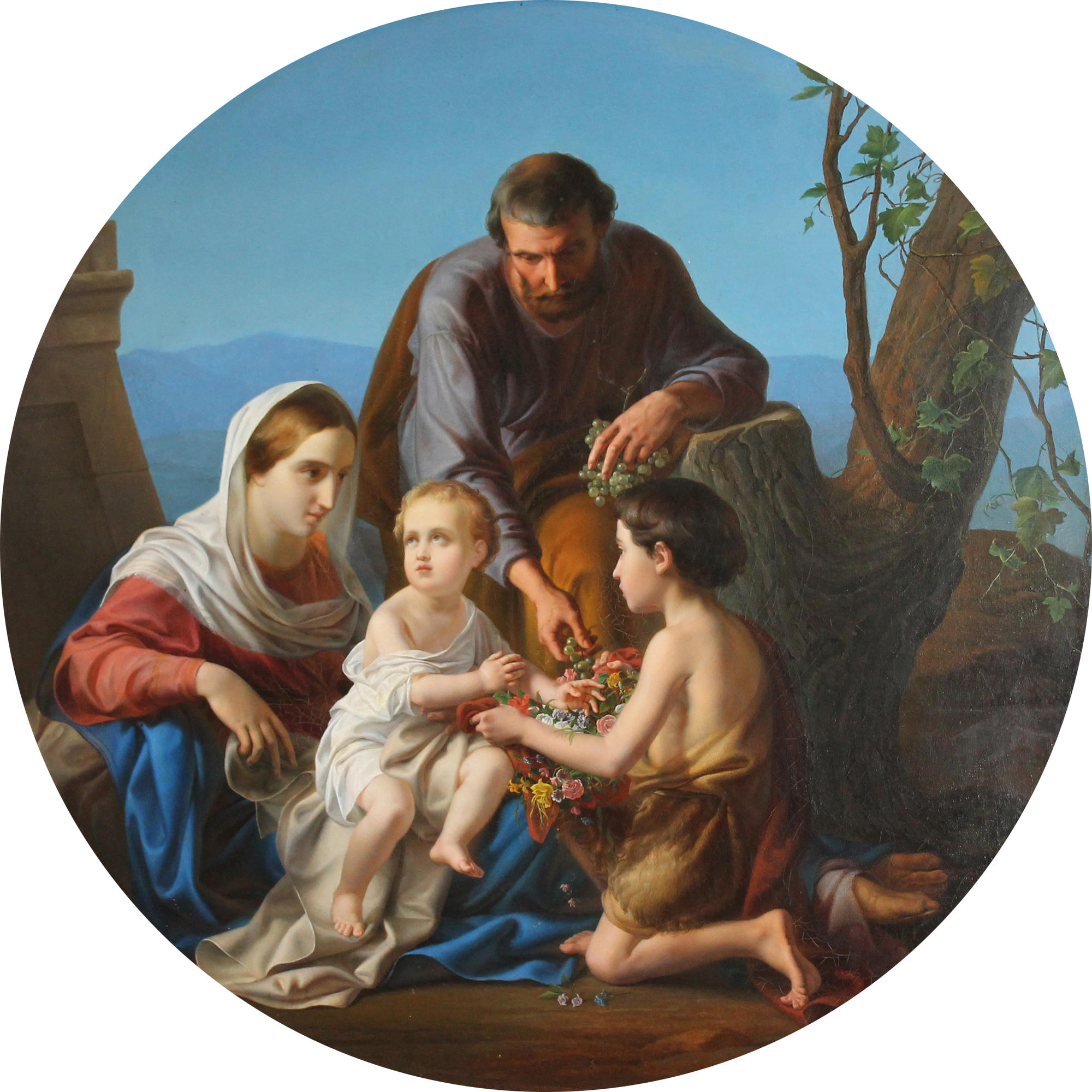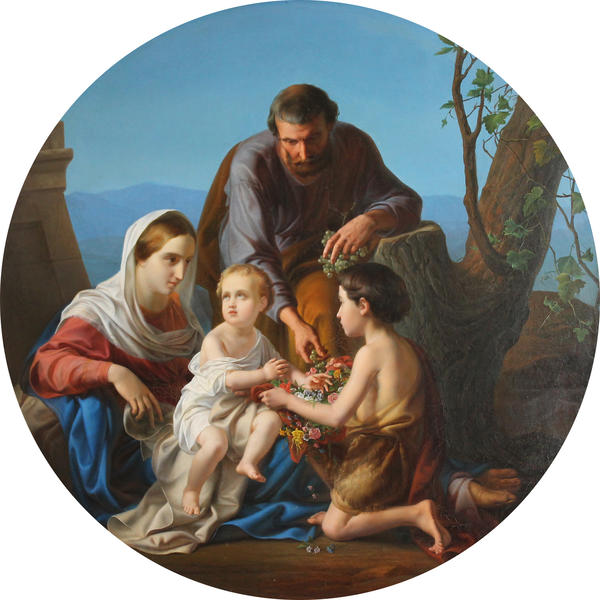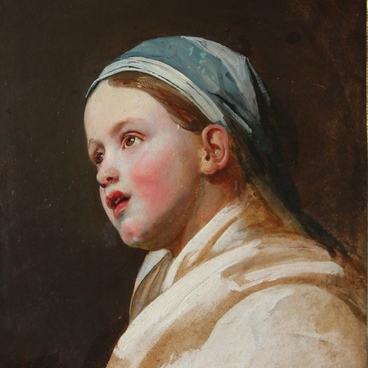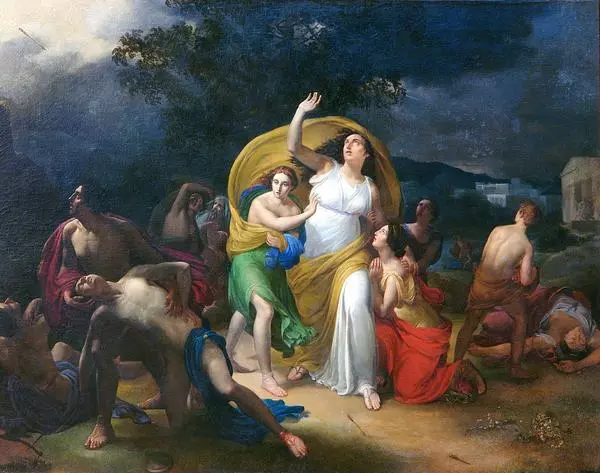The art of Petr Mikhailovich Shamshin is a bright example of Academism following the lofty standards of the art of Antiquity and Renaissance. An able draftsman and painter of the classical tradition, he dedicated most of his works to mythical and biblical themes.
The master was born in 1811 to a family of an artist. His father was a well-known academic of portraiture, Mikhail Nikitich Shamshin. So, the boy’s walk of life was predetermined from his early childhood. As early as at the age of ten, Petr began studying at the St. Petersburg Arts Academy. He studied under painter Petr Vasilyevich Basin known for his works on religious and historical themes.
In 1838, Shamshin graduated from the Academy with honours. His graduation work was inspired by Homer’s poem Iliad. The young master was awarded a small gold medal for his picture Hector, in Helen’s Bedroom, Rebukes Paris for Inaction. Two years before, he had been awarded a grand gold medal for his work also dedicated to ancient Greek mythology.
The awards entitled the beginning painter to a trip abroad to master his skills at the expense of the Society for the Encouragement of Artists. Italy overwhelmed Shamshin with its local colour, wealth of nature and beauty of local residents. He spent seven years there working ceaselessly.
After returning home, the artist began teaching at the Academy. It was a time when he dedicated himself to monumental church painting. The icons and wall paintings he created are in St. Isaac’s Cathedral, Christ the Saviour’s Cathedral, or the church of the Russian Embassy in Athens. In 1853, the painter was granted the rank of a professor for his picture Resurrection of Christ painted for the Arts Academy church.
Petr Shamshin finished his career when he was Rector of Painting and Sculpture, the post he occupied until a very old age and left shortly before he died. Shamshin required from his students strict adherence to academic canons.
The Holy Family was painted in 1856. In it, the artist follows the best traditions of Renaissance. The proportions are observed with mathematic accuracy. The rounded lines of the composition are emphasised by a similar shape of the frame.
The figures of Mary, Joseph, and John the Baptist form a triangle with baby Jesus in the centre. His face is turned to heaven. With a soft gesture, he waves aside the flowers presented to him by John. Joseph offers the baby a vine, which in Christianity is a symbol of Christ (‘I am the true vine, and my Father is the gardener.’) (John. XV, 1–6).
Using a biblical subject, the artist gets across the feelings and emotions of real people. The image of baby Jesus is in the focus of the viewers’ attention. The master has succeeded in committing to canvas the characters’ love for Infant God. Joseph is bent over the baby; his pose conveys care and desire to protect the family. The Mother of God, her face serene and content, is looking gently at the children.
The characters’ features are rendered with photographic precision; the picture is imbued with lyricism and exquisiteness. Knowledge of light and aerial perspective allowed the artist to soften the outlines of the figures in the landscape by fading haze, much like Leonardo da Vinci’s sfumato, — a technique used in painting to conveying the movement of air.
The master was born in 1811 to a family of an artist. His father was a well-known academic of portraiture, Mikhail Nikitich Shamshin. So, the boy’s walk of life was predetermined from his early childhood. As early as at the age of ten, Petr began studying at the St. Petersburg Arts Academy. He studied under painter Petr Vasilyevich Basin known for his works on religious and historical themes.
In 1838, Shamshin graduated from the Academy with honours. His graduation work was inspired by Homer’s poem Iliad. The young master was awarded a small gold medal for his picture Hector, in Helen’s Bedroom, Rebukes Paris for Inaction. Two years before, he had been awarded a grand gold medal for his work also dedicated to ancient Greek mythology.
The awards entitled the beginning painter to a trip abroad to master his skills at the expense of the Society for the Encouragement of Artists. Italy overwhelmed Shamshin with its local colour, wealth of nature and beauty of local residents. He spent seven years there working ceaselessly.
After returning home, the artist began teaching at the Academy. It was a time when he dedicated himself to monumental church painting. The icons and wall paintings he created are in St. Isaac’s Cathedral, Christ the Saviour’s Cathedral, or the church of the Russian Embassy in Athens. In 1853, the painter was granted the rank of a professor for his picture Resurrection of Christ painted for the Arts Academy church.
Petr Shamshin finished his career when he was Rector of Painting and Sculpture, the post he occupied until a very old age and left shortly before he died. Shamshin required from his students strict adherence to academic canons.
The Holy Family was painted in 1856. In it, the artist follows the best traditions of Renaissance. The proportions are observed with mathematic accuracy. The rounded lines of the composition are emphasised by a similar shape of the frame.
The figures of Mary, Joseph, and John the Baptist form a triangle with baby Jesus in the centre. His face is turned to heaven. With a soft gesture, he waves aside the flowers presented to him by John. Joseph offers the baby a vine, which in Christianity is a symbol of Christ (‘I am the true vine, and my Father is the gardener.’) (John. XV, 1–6).
Using a biblical subject, the artist gets across the feelings and emotions of real people. The image of baby Jesus is in the focus of the viewers’ attention. The master has succeeded in committing to canvas the characters’ love for Infant God. Joseph is bent over the baby; his pose conveys care and desire to protect the family. The Mother of God, her face serene and content, is looking gently at the children.
The characters’ features are rendered with photographic precision; the picture is imbued with lyricism and exquisiteness. Knowledge of light and aerial perspective allowed the artist to soften the outlines of the figures in the landscape by fading haze, much like Leonardo da Vinci’s sfumato, — a technique used in painting to conveying the movement of air.





